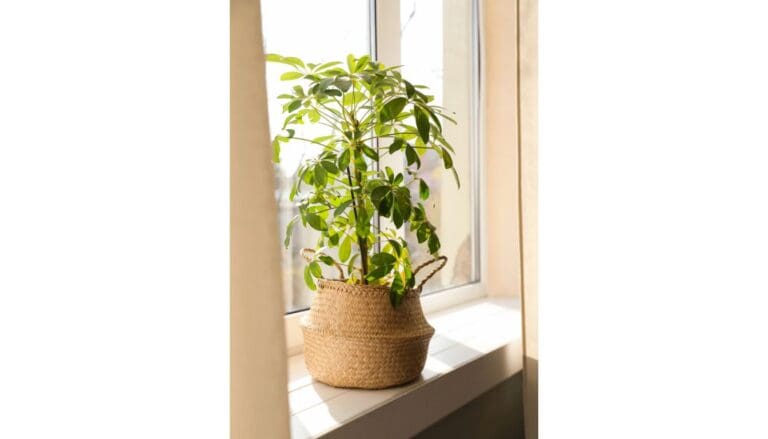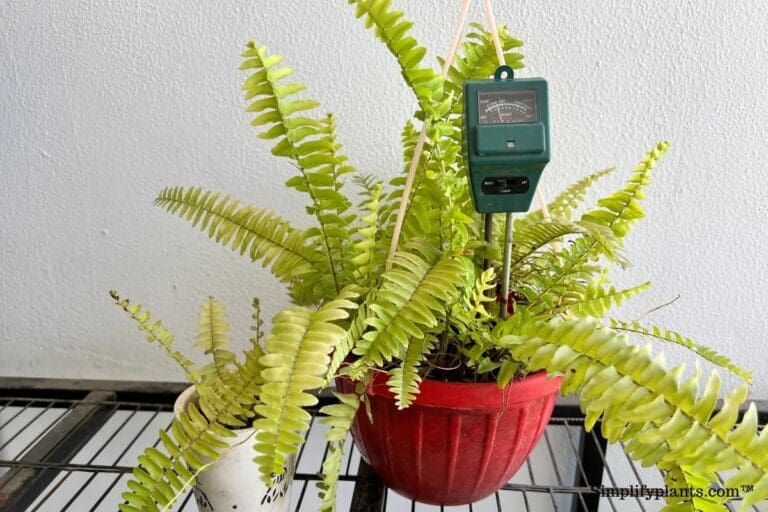Are Boston Ferns Indoor Or Outdoor Plants? (+Care Difference)
Boston ferns are bushy green plants that can elevate any space’s visual beauty, making them a universal favorite plant for plant owners. But there is confusion among many gardeners about whether they would grow the Boston ferns indoors or outdoors.
You can grow Boston ferns both outdoors and indoors under filtered sunlight. The best USDA zones to grow Boston outdoor are zone 9-11. For all other zones, you must consider growing them indoors. If you move them outside during summer, make sure to bring them indoors by fall.
However, what is important to remember is that wherever you grow them, you have to give them proper care and the right conditions.
This article will look into your Boston fern’s care needs and tips both indoors and outdoors. Keep reading to learn more.

Please note: Simplify Plants is reader-supported. Some links in the post are affiliate links and I get a commission from purchases made through links in the post.
Are Boston fern indoor plants or outdoor plants?
Plants owners can be quite confused about whether to grow their Boston ferns indoors or outdoors.
So the answer is you can grow them both indoors and outdoors, depending on the climate and region you live in.
The most important factor in growing them is giving them the right care and conditions to flourish.
Boston ferns love warmth and humidity.
So if you live in an area suitable for growing Boston ferns, go ahead and plant them and add a spark of bright color to dull spaces.
However, Boston ferns cannot tolerate harsh winters because they are warmth-loving plants.
If you reside in an area with harsh winters and the temperature goes below freezing point, you mustn’t leave your plant outside and bring it indoors.
When growing Boston ferns outdoors, it is best to keep them in a place where it gets partial sunlight, and indoors you can give them filtered sunlight.
The ideal temperature for Boston ferns is 60-75°F, and they can tolerate temperatures as low as 50°F.
However, below that can affect the plant’s health.
How to take care of Boston ferns outdoor?

Although these plants are often grown as houseplants, they can thrive outdoors in warm and humid climates of zones 9-11.
If the climate is drier, they can tolerate it if they get moisture through misting and other ways.
However, frost can kill the plant.
Let us now discuss the care tips for Boston ferns outdoors and what condition they should get in to thrive.
Light requirements
Boston ferns love to grow in the partial or full shade outdoors.
In their natural habitat, they live in humid spots under the bigger trees with filtered sunlight and are less exposed to strong winds.
If you have shady areas, this plant will do excellent in those spots.
Many people grow them on their patios or balconies with little to no direct sunlight.
You can keep the plant on the Eastern side of the house so that it gets dappled morning sunlight or hang it under patio roofs.
If you plant the Boston fern on the ground, then do that beneath a high-growing tree as it grows in nature.
One important factor to remember is that keep the plant guarded against the strong gush of winds because they tend to dry the soil quickly, which is not suitable for your Boston fern.
Also, strong winds can damage the delicate fronds of your Boston ferns.
Also read: What Kind Of Lighting Does A Boston Fern Need?
Soil

When you grow your Boston ferns outdoors, make sure you give the right soil to your plant.
It prefers organic-rich soil full of nutrients that is light and well-draining and at the same time hold moisture.
If you plant your fern in the soil bed directly, just dig a hole the same as the size of the pot and plant the plant in that hole so that the fern sits just above (1-2 inches) the ground surface.
Do not forget to check the soil pH, as ferns enjoy acidic soil with a pH of 6.0 to 6.5.
You can add a thick layer of compost, finely chopped bark, and leaf mulch to the garden soil bed to increase the soil’s humus while making it well-draining.
Also, introducing earthworms to the soil is a good way to create good air circulation so that the roots can breathe and do not get suffocated in the soil.
If you grow the plant in a pot or container, use good quality potting soil and mix perlite and peat moss with it to improve the airflow in the soil and ensure adequate drainage while making the soil able to hold moisture.
Also read: What Kind Of Soil For Boston Fern? (Ideal Soil Mix+How To Make)
Fertilization
Boston ferns are very light feeders, so do not overfertilize your Boston fern.
If you notice your plant leaves looking yellow and pale, it might indicate a lack of nutrients.
Notice the signs of the plant carefully.
You can feed the plant occasionally throughout the growing season using a dilute mixture of a regular, water-soluble fertilizer.
Alternatively, you can provide a slow-release fertilizer like compost and cow dung manure in spring 8 weeks later.
Also read: Should I Fertilize My Boston Fern? (Ideal Fertilizer+When & How Much)
Watering
Outdoors they need plenty of water.
Provide ample water to your outdoor Boston ferns to keep the soil constantly moist.
However, be very careful not to make the soil soggy and overwatered.
That can lead to diseases and root rot.
If you live in an area where summers are very hot and dry, you can mist your Boston ferns regularly to keep the moisture.
You might need to water your Boston ferns twice a day in the summers in such areas.
Also read: How To Water Boston Fern? (How Often, How Much & More)
Pest infestation

Although Boston ferns are quite hardy and pest resistant, they are susceptible to slugs attack.
If the infestation is mild, you can pick up those pests and drop them in a bucket of soapy water.
You can also use organic pesticides to discourage these pests, like sprinkling coffee powder around the slugs and using dry eggshells or diatomaceous earth around the slugs.
How to take care of Boston ferns indoors?
Boston ferns are popular indoor plants.
While growing them inside the homes, it is necessary to provide the right growing condition for them.
Making the indoor environment suitable to the Boston ferns’ needs is crucial to let it flourish and grow.
Most of our homes are quite dry, with heaters and air conditioners constantly running.
These are quite problematic for the health of your Boston ferns.
Let us now discuss how you can give the right environment to your fern indoors.
How to plant Boston ferns in pots?

- Boston ferns always prefer light well-draining soil that is acidic with a pH between 6.0 to 6.5. Prepare a good soil mix and put a layer of it in the pot you chose to use for the fern.
- Then carefully place the plant root ball in the center of the pot and pour soil on all the sides. Fill the pot, leaving a few inches empty on top for watering. Do not plant it too deep into the soil. You want to keep the crown above the soil to prevent infection or rot.
- Water the plant after re-potting it and not disturb it for a few days. Let the Boston fern get accustomed to the new environment.
- Remember to repot the plant only in spring and early summer. Do not repot it in fall or winter as the plant may not be able to tolerate the stress in the dormant period.
- Wait for 1-2 months after re-potting before fertilizing it again.
For the soil mix, you can use good quality potting soil and mix 1 part peat moss and 1 part perlite with it to make it well-draining and, at the same time, able to retain moisture.
Since these plants require humidity, you can double pot them.
Place it in a shallow terracotta pot with drainage holes and set it inside a slightly larger pot lined with damp sphagnum moss.
Water that evaporates from this moss will help to increase the humidity around the plant.
Also read: What Kind Of Pot Is Best For a Boston Fern? (Size, Material & More)
Light requirements when Boston ferns are growing indoors

Giving the right amount of light to plants while growing them indoors is vital for their growth.
Too much or too little light can affect the health of the fern.
You can place the plant where it will receive bright light but not scorching afternoon sun.
Morning sun from an East-facing window that is soft and mild will suit the plant very well.
If you have your plant in the South or West-facing window, you can hang a sheer curtain between the Boston fern and the window to create a barrier from the sunlight.
If you have a bright, airy bathroom or kitchen, you can place your fern there as they would be happy with the humidity around.
Do not forget to keep rotating the plant weekly so that all the sides get even light.
Keep the plant where it gets plenty of air circulation to avoid insects and fungus.
Watering the indoor Boston ferns
The watering schedule of your ferns depends on the weather and your plant’s water requirements.
One mistake plant parents most often do: is follow the same watering pattern all year round, and with Boston ferns, the chances of overwatering are very high.
Because they like moist soil, plant owners saturate them with water sometimes.
Not understanding that soggy soil leads to fungus growth in the plant root can lead to diseases and ultimately kill the plant.
In the same way, thirsty and dehydrated ferns can be seriously affected.
Before watering, check the top layer of the soil.
If it is sticking to your fingers, then don’t water it.
If the soil does not stick to your finger, you can water it.
You can also use a moisture meter to check this.
Always water the ferns fully until it runs out of the drainage holes.
Sometimes, your Boston ferns might need watering twice every day in scorching summer.
The water requirement is higher in spring and summer.
However, you have to cut down on watering in fall and winter because the evaporation rate is lesser.
If you water it the same way as you do in summers, it will lead to overwatering.
Fertilizing the indoor Boston ferns

Regularly feeding your Boston fern is another important care tip you must follow if you grow your ferns indoors.
Though Boston ferns are light feeders, they require sufficient food for healthy growth.
You can fertilize them with a balanced liquid fertilizer with a 20-10-20 NPK in the growing season.
Do not fertilize your Boston fern from fall to spring season because they go into dormancy in the winters, and feeding them can burn the roots.
Water the Boston fern a day before fertilizing it because fertilizing in dry soil can burn the plant.
Choosing a pot for the Boston ferns
Boston ferns would grow as large as the pots allow them to.
So choosing the right pot for your plant is crucial.
They are mostly sold in hanging baskets in the shops.
You can either leave them that way or repot them.
You must choose a pot no bigger than 2 inches from the existing pot to repot them.
Choose glazed terracotta or plastic pot for the ferns because they like moisture, and these materials are nonporous; hence take longer to dry out, keeping the soil moist for a longer duration.
Do not forget to choose pots with drainage holes to drain the excess water.
You can get self-watering pots for your Boston ferns because they help preserve moisture and not let the soil get bone dry in between waterings.
Other caring tips

Here are some quick tips you should keep while growing your Boston ferns.
- Boston ferns are tough, yet there are pests like spider mites that you have to protect your plant from. Mist the fronds to keep them clean and dust-free and spray them with Neem oil diluted in water from time to time to keep all bugs away.
- Your Boston ferns will not tolerate harsh winters at all. If your plant is outdoors, do not forget to bring it inside to shield it from the winters. It will not throw up new growth during this phase, but it is best not to disturb the plant much.
- If you live in a dry place, remember that you have to give additional humidity to your fern. There are various ways like using pebble trays, grouping plants, and using humidifiers to increase the area’s humidity.
- Prune your Boston ferns in the growing season when it begins to look scraggly or has dropped many leaves. Prune the dried-up yellow leaves and stems. Pruning helps to get rid of the dead leaves so that the plant can focus on pushing out new healthy leaves.
- Keep the Boston fern out of direct sunlight to protect its delicate fronds.
- Repot the ferns if you see it has begun to grow too big for the pot.
- In the winter, plant growth can slow down due to dormancy. Do not worry about it, and it will soon bounce back once spring comes.
- You can propagate your ferns in early spring by dividing the root ball into smaller clumps.
- Stop fertilizing the plant when it is already stressed. Analyze the signs of stress and then take necessary actions.
Final words
You must have understood where and how to grow your Boston ferns from the above discussion. You can grow the plant both indoors and outdoors, keeping in mind the plant’s requirements.
If your region has appropriate weather to grow this plant, you can go ahead with growing it outside. Otherwise, if you grow it indoors, you have to give sufficient light and humidity to the fern.
Recommended Garden Supplies
| Product Image | Our Recommended Gardening Supplies | Check Offers! |
|---|---|---|
Top Top
Top
Top
Top
Top
Top
Top
Top | rePotme Houseplant and Tropical Classic Potting Soil Mix | Check Offer On Amazon |
 Top
Top
Top
Top
Top
Top
Top
Top | Espoma Organic Indoor Plant Food | Check Offer On Amazon |
 Top
Top
Top
Top
Top
Top
Top
Top | GooingTop LED Grow Light 6000K Full Spectrum Clip Plant Growing Lamp | Check Offer On Amazon |
 Top
Top
Top
Top
Top
Top
Top
Top | Soil Moisture Meter | Check Offer On Amazon |
 Top
Top
Top
Top
Top
Top
Top
Top | Govee Hygrometer Thermometer, Bluetooth Enabled! | Check Offer On Amazon |
 Top
Top | LEVOIT Humidifiers for Large Room(Best For Plants) | Check Offer On Amazon |
 Top
Top
Top
Top
Top
Top
Top
Top | Upgraded DIY Automatic Drip Irrigation Kit, 15 Potted Houseplants Support | Check Offer On Amazon |
 Top
Top
Top
Top
Top
Top
Top
Top | Stainless Steel Heavy Duty Gardening Tool Set | Check Offer On Amazon |
 Top
Top
Top
Top
Top
Top
Top
Top | Bonide Insecticidal Soap | Check Offer On Amazon |
 Top
Top
Top
Top
Top
Top
Top
Top | Bonide 32 oz Spray Neem Oil for Organic Gardening | Check Offer On Amazon |
 Top
Top
Top
Top
Top
Top
Top
Top | Garden Safe Fungicide | Check Offer On Amazon |






